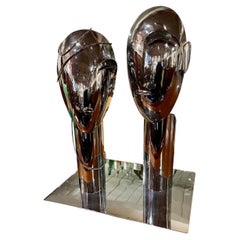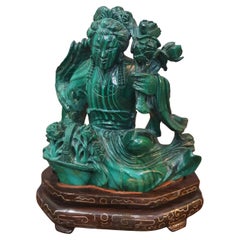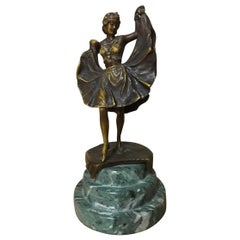Austrian Sculptures and Carvings
2
to
1
1
2
2
2
1
2
2
1
1
1
1
1
1
13,229
3,613
1,673
1,426
972
1
Place of Origin: Austrian
20th Century Terracotta Austrian Goldscheider Wien Stamped Sculpture, 1940s
Located in Vicoforte, Piedmont
Great Austrian sculpture from the 20th century. Terracotta vase carried by two children on an octagonal base. Oriental-style sculpture, finished for...
Category
1940s Vintage Austrian Sculptures and Carvings
Materials
Pottery
Franz Hagenauer Male and Female "The Couple" 1930
By Franz Hagenauer
Located in Oakland, CA
Franz Hagenauer Male and Female “The Couple” 1930. Rare sculpture highly stylized and unique piece made in Vienna, circa the 1930s. Recently restored in gleaming chrome patina portra...
Category
1930s Art Deco Vintage Austrian Sculptures and Carvings
Materials
Chrome
Related Items
20th Century Oriental Figure Sculpture in Malachite
Located in PALERMO, IT
Valuable sculpture depicting an oriental figure. Made from a single block of flowery malachite. Mounted on a carved wooden base.
Category
Early 20th Century Austrian Sculptures and Carvings
Materials
Malachite
20th Century Chinese Sculpture, Censer in Carved Jade
Located in Casale Monferrato, IT
20th century Beautiful sculpture in precious green jade made in china. Fine censer with carved decorations. The censer rests on a wooden base. Perfect conditions.
Category
1950s Vintage Austrian Sculptures and Carvings
Materials
Jade
Larger Than Life Terracotta Buddha Bust of Guanyin, Early 20th Century, China
Located in Antwerp, BE
A massive larger than life terracotta buddha bust of Guan Yin,
China, early 20th century.
Broken and restored with wear and tear from enduring exposure to the elements.
Size: 75 cm high.
Weight: 40 kg.
Guanyin, Kwanyin, Guanshiyin or Guanyin Pusa is the Chinese interpretation of the bodhisattva Avalokiteśvara (the goddess of comfort and mercy). In addition, she is seen in Taoism as an immortal. The scripture dedicated to her is Dabeizhou. Guanyin is the goddess of compassion and the sea. She is one of the three saints of the western paradise, along with Mahasthamaprapta and Amitabha Buddha; they are worshiped to save departed loved ones from hell and grant them entrance to the western paradise.
Guanyin
Chinese name
Traditional Chinese 觀音
Simplified Chinese 观音
Transcriptions
Full Chinese name
Traditional Chinese 觀世音
Simplified Chinese 观世音
Literal meaning "[The One Who] Perceives the Sounds of the World"
Transcriptions
Second alternative Chinese name
Traditional Chinese 觀自在
Simplified Chinese 观自在
Literal meaning "Lord who Gazes down on the World"
Transcriptions
Burmese name
Burmese ကွမ်ယင်
IPA [kwàɴ jɪ̀ɴ]
Tibetan name
Tibetan སྤྱན་རས་གཟིགས
Vietnamese name
Vietnamese alphabet Quan Âm (Quán Âm)
Quán Thế Âm (Quan Thế Âm)
Quán Tự Tại
Chữ Hán 觀音
觀世音
觀自在
Thai name
Thai กวนอิม, พระอวโลกิเตศวรโพธิสัตว์
RTGS Kuan Im, Phra Avalokitesuan
Korean name
Hangul 관음, 관세음, 관자재
Hanja 觀音, 觀世音, 觀自在
Transcriptions
Mongolian name
Mongolian script ᠨᠢᠳᠦ ᠪᠡᠷ
ᠦᠵᠡᠭᠴᠢ
Japanese name
Kanji 観音, 観世音, 観自在
Hiragana かんのん, かんぜおん, かんじざい
Transcriptions
Indonesian name
Indonesian Kwan Im, Kwan She Im, Awalokiteswara
Filipino name
Tagalog Guanyin (ᜄᜓᜀᜈᜌᜒᜈ)
Sanskrit name
Sanskrit अवलोकितेश्वर (Avalokiteśvara)
Khmer name
Khmer អវលោកិតេស្វរៈ (Avalokitesvarak), អវលោកេស្វរៈ (Avalokesvarak), លោកេស្វរៈ (Lokesvarak)
Hmong name
Hmong Kabyeeb, Niam-Txiv Kabyeeb, Dabpog, Niam-Txiv Dabpog
Guanyin (traditional Chinese: 觀音; simplified Chinese: 观音; pinyin: Guānyīn) is a Bodhisattva associated with compassion. She is the East Asian representation of Avalokiteśvara (Sanskrit: अवलोकितेश्वर) and has been adopted by other Eastern religions, including Chinese folk religion.[note 1] She was first given the appellation "Goddess of Mercy" or "Mercy Goddess" by Jesuit missionaries in China.[1] Guanyin is short for Guanshiyin, which means "[The One Who] Perceives the Sounds of the World."[2] On the 19th day of the sixth lunar month, Guanyin's attainment of Buddhahood is celebrated.[3]
Some Buddhists believe that when one of their adherents departs from this world, they are placed by Guanyin in the heart of a lotus, and then sent to the western pure land of Sukhāvatī.[4] Guanyin is often referred to as the "most widely beloved Buddhist Divinity"[5] with miraculous powers to assist all those who pray to her, as is mentioned in the Pumen chapter of Lotus Sutra and Kāraṇḍavyūha Sūtra.
Several large temples in East Asia are dedicated to Guanyin, including Shaolin Monastery, Longxing Temple, Puning Temple, Nanhai Guanyin Temple, Dharma Drum Mountain, Kwan Im Thong Hood Cho Temple, Shitennō-ji, Sensō-ji, Kiyomizu-dera, Sanjūsangen-dō, and many others. Guanyin's abode and bodhimaṇḍa in India is recorded as being on Mount Potalaka. With the localization of the belief in Guanyin, each area adopted their own Potalaka. In Chinese Buddhism, Mount Putuo is considered the bodhimaṇḍa of Guanyin. Naksansa is considered to be the Potalaka of Guanyin in Korea. Japan's Potalaka is located at Fudarakusan-ji. Tibet's Potalaka is the Potala Palace. Vietnam's Potalaka is the Hương Temple.
There are several pilgrimage centers for Guanyin in East Asia. Putuoshan is the main pilgrimage site in China. There is a 33 temple Guanyin pilgrimage in Korea which includes Naksansa. In Japan, there are several pilgrimages associated with Guanyin. The oldest one of them is the Saigoku Kannon Pilgrimage, a pilgrimage through 33 temples with Guanyin shrines. Guanyin is beloved by most Buddhist traditions in a nondenominational way and found in most Tibetan temples under the name Chenrézik (Wylie: Spyan ras gzigs). Guanyin is also beloved and worshipped in the temples in Nepal. The Hiranya Varna Mahavihar located in Patan is one example. Guanyin is also found in some influential Theravada temples such as Gangaramaya Temple, Kelaniya and Natha Devale nearby Temple of the Tooth...
Category
Early 20th Century Chinese Export Austrian Sculptures and Carvings
Materials
Terracotta
H 30.71 in W 22.84 in D 14.57 in
Asian Khmer Cambodia Stoned Carved Head Bust of Male Buddhist Buddha Shiva Deity
Located in Studio City, CA
A wonderfully sand stone-carved Asian deity figure / sculpture likely from Cambodia. The detailed head is likely that of the divinity deity Shiva, sometimes referred to as the smiling God-King. The features are clearly reminiscent of the carvings found at both Bayon Temple at Angkor Thom...
Category
19th Century Antique Austrian Sculptures and Carvings
Materials
Sandstone
H 7 in W 4.5 in D 4 in
20th Century Chinese Sculpture, Tree with Birds in Carved Jade
Located in Casale Monferrato, IT
20th century Beautiful sculpture in precious green jade made in china. High artistic quality a tree with many leaves among whose branches some birds can be seen. The sculpture rests ...
Category
1950s Vintage Austrian Sculptures and Carvings
Materials
Jade
Vintage Chinese Serpentine Sculpture, China, Early 20th Century
Located in Roma, IT
Vintage Chinese serpentine sculpture is a traditional decorative object realized in china in the early 20th century.
Serpentine m...
Category
Early 20th Century Austrian Sculptures and Carvings
Materials
Marble, Serpentine
20th Century Chinese Sculpture, Geisha in Carved Jade
Located in Casale Monferrato, IT
20th century Beautiful sculpture in precious green jade made in china. Fine figure of geisha with elegant kimono and lotus flower. The sculpture rests on a wooden base. Perfect condi...
Category
1950s Vintage Austrian Sculptures and Carvings
Materials
Jade
20th Century Leone Classico Statuette, Italian Terracotta Decor
Located in West Palm Beach, FL
A vintage Italian classic Tuscan terracotta clay statuette of a regal lion in a guardian position, in good condition. Wear consistent with age ...
Category
Early 20th Century Art Deco Austrian Sculptures and Carvings
Materials
Terracotta
No Reserve
H 24.75 in W 10.5 in D 21.25 in
20th Century Chinese Sculpture, Buddha in Carved Jade
Located in Casale Monferrato, IT
20th century beautiful sculpture in precious green jade made in china. fine figure of Standing Buddha. The sculpture rests on a wooden base. Perfect conditions.
Category
1950s Vintage Austrian Sculptures and Carvings
Materials
Jade
Bronze Tibetan Couple Statue Vajrasattva Yab Yum
Located in Somis, CA
A rare statue of the joined Tibetan Deities Yab-yum (in Tibetan "father-mother"). The statue represents the primordial union of wisdom and compassion, de...
Category
19th Century Antique Austrian Sculptures and Carvings
Materials
Bronze
Benedicte Bergmann Wooden Dolls part of the Mythological Sisters Series, 1969
Located in Bochum, NRW
Three hand-carved wooden dolls by the Swedish artist Benedicte Bergmann. Part of the hand carved wooden dolls "Mythological Sisters", started by th...
Category
1980s Vintage Austrian Sculptures and Carvings
Materials
Wood
"Leda" Armchair Sculpture by Salvador Dalí 20th Century Surrealist design
By Salvador Dalí, BD Barcelona Design
Located in Barcelona, ES
Armchair model "Leda"
Structure in polished cast brass varnish.
Salvador Dali
Taken from “Femme à tête de roses" (1935)” 1935 (Woman with a head of roses). It was sufficient for this sculpture to be made as a three dimensional piece, remaining faithful to every detail in Dalí’s painting.
Dalí affirmed: “A chair can be used even to sit on, but only on one condition: That we sit uncomfortably.” We can sit on the Leda, but due to the fact that it only has three legs and that the chair is heavy, it being made of solid brass, is more a work of art than a functional piece of furniture.
© Salvador Dalí, Fundació Gala-Salvador Dalí, Figueres, 2022
Artworks by Salvador Dalí: © Salvador Dalí, Fundació Gala-Salvador Dalí, VEGAP, Barcelona, 2022
Salvador Dalí is the most versatile and prolific artists of the 20th century and the most famous Surrealist. Though chiefly remembered for his painterly output, in the course of his long career he successfully turned to sculpture, printmaking, fashion, advertising, writing, filmmaking and design.
Born in Figueres, Catalonia, Dalí received his formal education in fine arts in Madrid. Influenced by Impressionism and the Renaissance masters from a young age, he became increasingly attracted to Cubism and avant-garde movements. He moved closer to Surrealism in the late 1920s and joined the Surrealist group in 1929, soon becoming one of its leading exponents.
In the Paris of the 1930s, Dalí surrounded himself with a circle of friends working in the application of art to a number of varied disciplines, beyond the study of purely pictorial art. One of these, Jean-Michel Frank, an acclaimed furniture designer and decorator in Paris at that time, got on extremely well with Dalí, and together they developed a number of ideas. One example of this is the Bracelli lamp, a classic design in Jean-Michel’s manner of designing and working that Dalí adopted for his home in Portlligat.
Among Dalí’s projects, which add to his CV as a designer, are the garden furniture for his home in Portlligat, the complete architecture of the Night Club (in the shape of a hedgehog) for the Hotel Presidente in Acapulco (1957) and a project for a bar in California in the 1940s.
His creations were not limited to traditional furniture elements, but included taps, handles, knobs, prints and objects of indeterminate use. In 1933, Dalí even registered the patent for the design of a bench as an outdoor seat. In the 1990s, a team of experts led by Oscar Tusquets set out to bring to life the furniture that Dalí had sketched for Jean-Michel Frank, including the Leda chair and low table taken from the 1935 painting “Femme...
Category
21st Century and Contemporary Modern Austrian Sculptures and Carvings
Materials
Brass
H 36.23 in W 23.63 in D 18.51 in
Previously Available Items
Near Life-Size Polychrome Bronze of a Native American Indian Chief after Kauba
By Carl Kauba
Located in New York, NY
Rare Near Life-Size Polychrome Bronze of a Native American Indian Chief after Carl Kauba, 20th century.
This magnificent quality bronze, stands 52" tall and it depicts an American Indian chief with full a full uniform cast in solid bronze.
Beautiful, bright and vibrant colors. Would stand out in any room and give life to anyone looking at it.
52" high x 29" wide x 18" deep
Very good condition. Ready to place.
Carl Kauba was born August 13, 1865 in Vienna, Austria. The son of a shoemaker, Kauba chose to follow his calling into the world of art. Collectors now rank him in a class with Remington and Russell as one of the great portrayers of American Western. His subjects were typically American Indians, calvarymen, cowboys, and roughriders. In addition to his American bronzes, Kauba produced a lifetime’s worth of Austrian statuary. His work became fully appreciated on both sides of the Atlantic.
Carl studied at the Academy of Fine Arts in Vienna under professor Laufenberg. Later he would study at the academies under Carl Waschmann and Stefan Schwartz. Next, he went to Paris in 1886 to further study before he set off for the U.S. In fact, some debate still remains as to whether Kauba ever visited the U.S.
Kauba’s fascination with the West was fired by the stories of the German writer, Carl May, whose tales of Western adventure were well known throughout Europe. Most authorities feel that he was about twenty-five years old when he traveled widely throughout the American West. He then returned to Austria with voluminous notes, sketches, and several models of Western sculpture...
Category
20th Century Austrian Sculptures and Carvings
Materials
Bronze
H 52 in W 29 in D 18 in
Art Nouveau Franz Xavier Bergman Oriental Vienna Bronze, 1900s
By Franz Bergmann
Located in LEGNY, FR
Very nice Art nouveau Franz Xavier Bergman oriental dancer Vienna bronze from the 1900s on a marble base.
Bergman was signing his creations with ...
Category
20th Century Art Nouveau Austrian Sculptures and Carvings
Materials
Bronze
Josef Lorenzl Scarf Dancer IV
By Josef Lorenzl
Located in Forest Row, East Sussex
Scarf Dancer IV, an Art Deco, cold painted bronze figure. Depicts a young lady in stylised pose, draped elegantly in a scarf, set over a green onyx plinth...
Category
20th Century Art Deco Austrian Sculptures and Carvings
Materials
Bronze
Josef Lorenzl Scarf Dancer
By Josef Lorenzl
Located in Forest Row, East Sussex
Scarf dancer, an Art Deco, cold painted bronze figure. Depicts a young lady draped elegantly in a scarf, set over a green onyx plinth.
Inscribed J Lor ...
Category
20th Century Art Deco Austrian Sculptures and Carvings
Materials
Bronze
Read More
12 Calming Spaces Inspired by Japanese Design
From cherry-blossom-adorned walls paired with glamorous lighting to wood-paneled ceilings above checkerboard-patterned chairs, these 12 spaces seamlessly blend Eastern and Western aesthetics.
Rodrigo Rivero Lake’s Mexico City Showroom Is a Museum-Worthy Trove of Spanish Colonial and Asian Antiques
The dealer and curator has spent the past 50 years amassing a collection of exceptional art, furniture and architectural elements that trace the cultural influence of the Spanish empire from Europe to the Americas and beyond.
Recently Viewed
View AllMore Ways To Browse
Chinese Bell
Dragon Stone
Chinese Antique Furniture New York
Antique Chinese Furniture New York
Scale Chinese Wood
Wood Shrine
Japanese Cast Lantern
Small Japanese Carving
Wood Basin
Japanese Lantern Outdoor
Tall Pair Japanese
Ancient Wood Carvings
Green Stone Carving
Antique Japanese Buddhist
Temple Door
Box Lantern
Asian Arch
Large Buddha Hand




